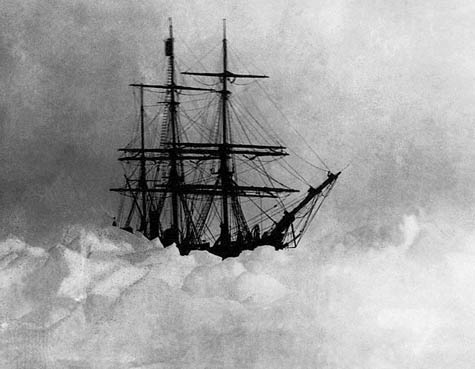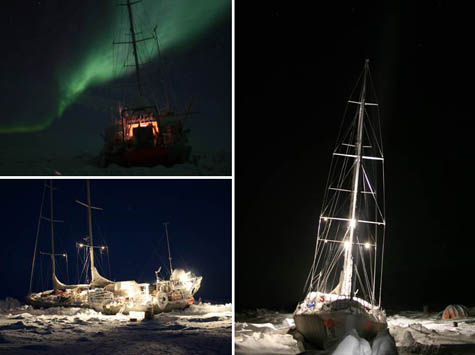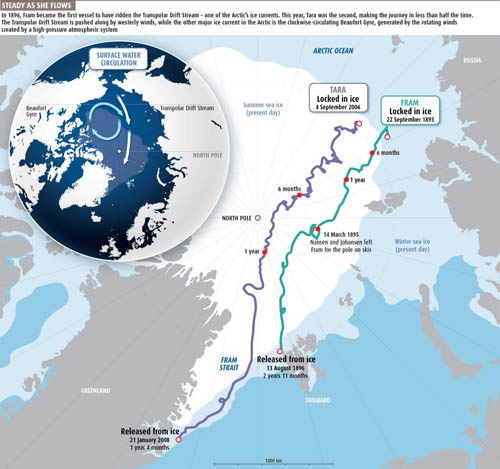The Architecture of Polar Ice Floes
 [Image: Trapped in ice].
[Image: Trapped in ice].Back in January 2008, a ship called Tara unlocked from the polar ice near Greenland; it had been frozen in the Arctic floes for a year and four months, repeating the journey of the Fram, a Norwegian ship that once drifted across the polar seas, frozen solid in the ice fields, back in 1896.
In both cases, the ships temporarily became buildings, works of architecture wed flush with the landscape surrounding them.
 [Images: Photos via Jules Verne Adventures].
[Images: Photos via Jules Verne Adventures].As reported two winters ago in the Times:
- Visitors to the North Pole in the past 15 months might have happened upon a peculiar sight: a ship, high and dry on the ice pack, her masts upright against the flaming aurora borealis, her bow pointing over the ice sheet, as if sailing on a sea of snow. They might have thought it a polar mirage.
In a description so strange I have trouble visualizing it, we read about a "pressure ridge" that moved toward the boat at "super-slow" speeds, threatening everyone on board with destruction:
- There was another scare that winter with a “pressure ridge” caused by colliding plates of ice advancing towards the boat. “It was like a frozen wave, moving in super-slow motion—about a centimeter a second,” said [a crew member]. “At one stage we attacked it with picks and chainsaws, but there was no way we could stop it.” It leant over the boat, then suddenly it stopped by itself and “we were released from the pinch,” said [the crew member].
 [Image: Map of the Arctic ice routes that brought ships across the sea, courtesy of New Scientist].
[Image: Map of the Arctic ice routes that brought ships across the sea, courtesy of New Scientist].But what interests me here is the idea that you could build one thing—a ship—that only becomes what it's really meant to be—a building—when the circumstances it's surrounded by undergo a phase change (here, water turning into ice).
The ship's hull was specifically designed for this, we read in New Scientist; it was "broad, smooth and round so that, rather than being crushed like an egg, the boat would pop up like an olive stone squeezed between finger and thumb, and sit on top of the pack ice. It also featured a lifting centerboard instead of a fixed keel, and removable propellers and rudders. These precautions worked: Tara suffered just a small dent at the stern, and another stretching a metre or so along the hull."
What might the atmospheric equivalent of this be? Perhaps a planetary probe dropped into the skies of Titan or Enceladus, awaiting some strange aerial phase change to occur on all sides?
And, speaking of other planets, could you ever encounter such extraordinary air pressure—on a gas giant, say—such that solid objects simply become trapped in place, unable to fall any further? The atmosphere beneath them is denser than the metal they are made from.
Like machine-fossils buried transparently in air—or like Arctic ships locked in ice—NASA probes would gradually decay, compressed by nothing but air, under deformational pressures lasting tens of millions of years. Aerial tectonics. Slow weather. Sky glacier.
http://bldgblog.blogspot.com/2010/02/architecture-of-polar-ice-floes.html

wow what an amazing story and set of images! really good reading. totally fascinating. I couldn't help but wonder what happened to the occupants of these ships. I guess they evacuated at one point... right?
ReplyDeletei mean, i hope so. unless they just sort of molded into the ship, which would be cool in a creepy sort of way.
ReplyDelete